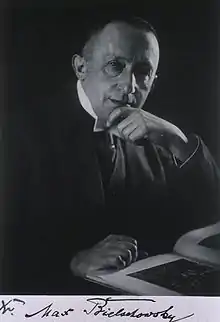Max Bielschowsky | |
|---|---|
 | |
| Born | Max Israel Bielschowsky 20 February 1869 |
| Died | 15 August 1940 (aged 71) |
| Nationality | German |
| Occupation | Neuropathologist |
Max Israel Bielschowsky (20 February 1869 – 15 August 1940) was a German neuropathologist born in Breslau.[1]
After receiving his medical doctorate from the University of Munich in 1893, he worked with Ludwig Edinger (1855–1918) at the Senckenberg Pathology Institute in Frankfurt-am-Main. At Senckenberg he learned histological staining techniques from Carl Weigert (1845–1904). From 1896 to 1904 he worked in Emanuel Mendel's (1839–1907) psychiatric laboratory in Berlin. In 1904 he joined Oskar Vogt (1870–1959) at the neurobiological laboratory at the University of Berlin, where he remained until 1933. Later in his career he worked at the psychiatric clinic at the University of Utrecht, and at the Cajal Institute in Madrid.[2] He emigrated to the UK, where he died on 15 August 1940 in the Greater London area at 71 years of age.[3] His oldest son, Franz David Bielschowsky, also emigrated to Sheffield, UK and subsequently to Dunedin, New Zealand where he pursued an eminent career in cancer research.[4] A cousin of Max Bielschowsky, Albert Bielschowsky (1847–1902), was a biographer of Johann Wolfgang von Goethe.[4]
Bielschowsky made important contributions in his research of tuberous sclerosis, amaurotic idiocy, paralysis agitans, Huntington’s chorea and myotonia congenita. He is remembered for his histopathological work with disseminated sclerosis, the use of an histological silver stain for impregnation of nerve fibers, and with Stanley Cobb, the development of intravital[5] silver staining. The eponymous "Bielschowsky silver stain" technique was an improvement on the method developed by Ramon y Cajal (1852–1934).[2]
Selected written works
- Die Silberimprägnation der Achsencylinder; Neurologisches Zentralblatt, Leipzig, 1902, 21: 579–84. Neurologisches Zentralblatt, Leipzig, 1903, 22: 997–1006; (Bielschowsky stains).
- Allgemeine Histologie und Histopathologie des Nervensystems. In: Max Lewandowsky (publisher), Handbuch der Neurologie. Volume 1, Berlin, 1910.
- Herpes Zoster. In: Max Lewandowsky (publisher): Handbuch der Neurologie. Volume 5, Berlin, 1910.
- Über spätinfantile familiäre amaurotische Idiotie mit Kleinhirnsymptomen. Deutsche Zeitschrift für Nervenheilkunde, 1914, 50: 7–29. (Bielschowsky’s amaurotic idiocy).
See also
References
- ↑ The National Archives, Kew, London, England, HO 396 WW2 Internees (Aliens) Index Cards 1939–1947, Referencenumber HO 396/217, Exemption From Internment Document, dated 12 April 1939 for Max Israel Bielefeldt, In: Ancestry.com
- 1 2 Enersen, Ole Daniel. "Max Bielschowsky". Who Named It. Retrieved 31 May 2009.
- ↑ Stahnisch, FW (2015). "Max Bielschowsky (1869–1940)". J Neurol. 262 (3): 792–4. doi:10.1007/s00415-014-7544-z. PMC 4363476. PMID 25346063.
- 1 2 Bonser, GM (1967). "Franz David Bielschowsky 5 January 1902 – 21 April 1965". J Pathol Bacteriol. 93 (1): 357–364. doi:10.1002/path.1700930141. PMID 5339802.
- ↑ Cobb, Stanley; Bielschowsky, Max (1925). "A method for intra-vital staining with silver ammonium oxide solution". Journal für Psychologie und Neurologie. 31: 301–304.